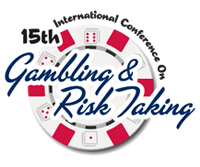Presentation Type
Event
Location
Caesars Palace, Las Vegas Roman Ballroom
Start Date
29-5-2013 10:00 AM
End Date
29-5-2013 10:30 AM
Disciplines
Gaming and Casino Operations Management | Mental and Social Health | Physiological Processes | Psychology | Sociology | Substance Abuse and Addiction
Abstract
Introduction
Gamblers experience exposure to gambling cues on a daily basis, ranging from celebrity-endorsed TV commercials, to walking past a high street bookmaker. Research on substance addictions indicates that these cues are likely to activate urges / cravings to gamble.
Wulfert et al (2005) found higher ratings of subjective excitement following a horse race with a wager on in students, Kushner et al (2008) used frequent gamblers in a simulated casino environment and found positive anticipation and positive priming increased urges to gamble, however these studies used only a single self report item to measure craving. Ashrafioun et al (2012) used the Gambling Urge Scale (GUS, Raylu & Oei, 2004b) and found increases in craving following gambling cues in student gamblers.
Craving comprises the short-term, acute ‘urges’ to obtain relief and reward (Raylu & Oei, 2004b), as well as more stable aspects of ‘preoccupation’ (Pallanti et al, 2005). The current study used the Gambling Craving Scale (Young & Wohl, 2009) to measure stable preoccupation, and the three most heavily loaded factors from the GACS to capture short-term gambling urges generated by the images / adverts on a block by block basis, thus capturing both facets of craving.
Previous studies have used heart rate and skin conductance levels to measure physiological arousal following gambling cues, finding increased reactivity recreational gamblers (Ladouceur et al 2003) and pathological gamblers (Sodano et al 2010). However, different physiological parameters tend not to correlate with each other, or with subjective craving measures (Diskin et al, 2003) suggesting physiological and psychological measures are not necessarily capturing the same elements of craving. Arousal has been measured following different cue types videos and images, but to date not actual gambling adverts.
When differentiating between different gambling forms, Sharpe & Tarrier (1995) showed EGM players showed increased skin conductance responses to EGM cues compared to horse race cues, while Franco et al (2008) demonstrated significant increases in heart rate in horse gamblers following exposure to horse races compared to scratchcards. We compared craving ratings and physiological responses to preferred and non-preferred games in pathological gamblers.
Included in
Gaming and Casino Operations Management Commons, Physiological Processes Commons, Psychology Commons, Sociology Commons, Substance Abuse and Addiction Commons
Mid-morning Break and Poster Sessions: Psychological and physiological responses to gambling cues in pathological gamblers
Caesars Palace, Las Vegas Roman Ballroom
Introduction
Gamblers experience exposure to gambling cues on a daily basis, ranging from celebrity-endorsed TV commercials, to walking past a high street bookmaker. Research on substance addictions indicates that these cues are likely to activate urges / cravings to gamble.
Wulfert et al (2005) found higher ratings of subjective excitement following a horse race with a wager on in students, Kushner et al (2008) used frequent gamblers in a simulated casino environment and found positive anticipation and positive priming increased urges to gamble, however these studies used only a single self report item to measure craving. Ashrafioun et al (2012) used the Gambling Urge Scale (GUS, Raylu & Oei, 2004b) and found increases in craving following gambling cues in student gamblers.
Craving comprises the short-term, acute ‘urges’ to obtain relief and reward (Raylu & Oei, 2004b), as well as more stable aspects of ‘preoccupation’ (Pallanti et al, 2005). The current study used the Gambling Craving Scale (Young & Wohl, 2009) to measure stable preoccupation, and the three most heavily loaded factors from the GACS to capture short-term gambling urges generated by the images / adverts on a block by block basis, thus capturing both facets of craving.
Previous studies have used heart rate and skin conductance levels to measure physiological arousal following gambling cues, finding increased reactivity recreational gamblers (Ladouceur et al 2003) and pathological gamblers (Sodano et al 2010). However, different physiological parameters tend not to correlate with each other, or with subjective craving measures (Diskin et al, 2003) suggesting physiological and psychological measures are not necessarily capturing the same elements of craving. Arousal has been measured following different cue types videos and images, but to date not actual gambling adverts.
When differentiating between different gambling forms, Sharpe & Tarrier (1995) showed EGM players showed increased skin conductance responses to EGM cues compared to horse race cues, while Franco et al (2008) demonstrated significant increases in heart rate in horse gamblers following exposure to horse races compared to scratchcards. We compared craving ratings and physiological responses to preferred and non-preferred games in pathological gamblers.


Comments
File: Poster